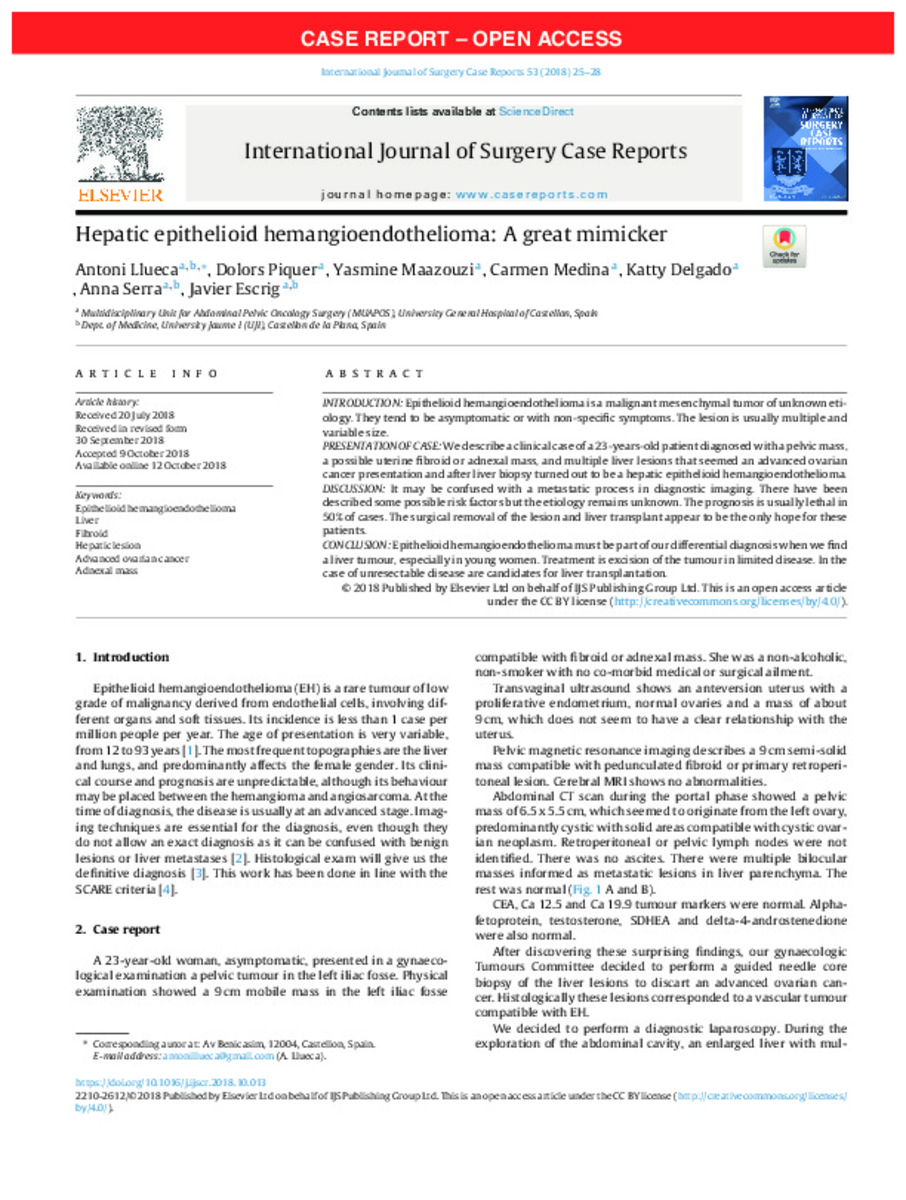Mostrar el registro sencillo del ítem
Hepatic epithelioid hemangioendothelioma: A great mimicker
| dc.contributor.author | Llueca, Antoni | |
| dc.contributor.author | Piquer Simó, Dolors | |
| dc.contributor.author | Maazouzi, Yasmine | |
| dc.contributor.author | Medina, Carmen | |
| dc.contributor.author | Delgado Barriga, Katty | |
| dc.contributor.author | Serra Rubert, Anna | |
| dc.contributor.author | Escrig-Sos, Javier | |
| dc.date.accessioned | 2018-12-14T12:28:08Z | |
| dc.date.available | 2018-12-14T12:28:08Z | |
| dc.date.issued | 2018-10 | |
| dc.identifier.citation | LLUECA, Antoni, et al. Hepatic epithelioid hemangioendothelioma: A great mimicker. International journal of surgery case reports, 2018, 53: 25-28. | ca_CA |
| dc.identifier.uri | http://hdl.handle.net/10234/178136 | |
| dc.description.abstract | INTRODUCTION: Epithelioid hemangioendothelioma is a malignant mesenchymal tumor of unknown etiology. They tend to be asymptomatic or with non-specific symptoms. The lesion is usually multiple and variable size. PRESENTATION OF CASE: We describe a clinical case of a 23-years-old patient diagnosed with a pelvic mass, a possible uterine fibroid or adnexal mass, and multiple liver lesions that seemed an advanced ovarian cancer presentation and after liver biopsy turned out to be a hepatic epithelioid hemangioendothelioma. DISCUSSION: It may be confused with a metastatic process in diagnostic imaging. There have been described some possible risk factors but the etiology remains unknown. The prognosis is usually lethal in 50% of cases. The surgical removal of the lesion and liver transplant appear to be the only hope for these patients. CONCLUSION: Epithelioid hemangioendothelioma must be part of our differential diagnosis when we find a liver tumour, especially in young women. Treatment is excision of the tumour in limited disease. In the case of unresectable disease are candidates for liver transplantation. | ca_CA |
| dc.format.extent | 3 p. | ca_CA |
| dc.format.mimetype | application/pdf | ca_CA |
| dc.language.iso | eng | ca_CA |
| dc.publisher | Elsevier | ca_CA |
| dc.rights | © 2018 Published by Elsevier Ltd on behalf of IJS Publishing Group Ltd. This is an open access article under the CC BY license (http://creativecommons.org/licenses/by/4.0/). | ca_CA |
| dc.rights | Atribución 4.0 Internacional | * |
| dc.rights.uri | http://creativecommons.org/licenses/by-sa/4.0/ | * |
| dc.subject | epithelioid hemangioendothelioma | ca_CA |
| dc.subject | liver | ca_CA |
| dc.subject | fibroid | ca_CA |
| dc.subject | hepatic lesion | ca_CA |
| dc.subject | advanced ovarian cancer | ca_CA |
| dc.subject | adnexal mass | ca_CA |
| dc.title | Hepatic epithelioid hemangioendothelioma: A great mimicker | ca_CA |
| dc.type | info:eu-repo/semantics/article | ca_CA |
| dc.identifier.doi | https://doi.org/10.1016/j.ijscr.2018.10.013 | |
| dc.rights.accessRights | info:eu-repo/semantics/openAccess | ca_CA |
| dc.relation.publisherVersion | https://www.sciencedirect.com/science/article/pii/S221026121830436X | ca_CA |
| dc.contributor.funder | Medtronic University Chair for Training and Surgical Research (University Jaume I - UJI. Castellon, Spain). | ca_CA |
| dc.type.version | info:eu-repo/semantics/publishedVersion | ca_CA |
Ficheros en el ítem
Este ítem aparece en la(s) siguiente(s) colección(ones)
-
MED_Articles [636]
Articles de publicacions periòdiques








